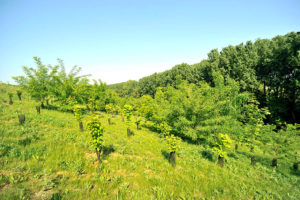A unique land reclamation glossary
Within a framework of urban metabolism and the circular economy, ECT recycles excavated soil from construction sites.
This recycling of excavated soil is part of a regulatory framework for soil characterization and traceability.
The reuse of inert soil enables ECT to recycle derelict land by returning it to a use agreed with the local community. To satisfy this new use, ECT creates landscaped parks, nature areas, afforestation or agricultural rehabilitation at no cost to the community.
Urban agriculture
Urban agriculture takes over urban spaces that have been converted to agricultural use. Urban agriculture comes in all shapes and sizes.
A concerted urban agriculture project can take the form of :
- orchard
- market gardening
- apiary
- educational garden
- family garden
- shared garden
ECT proposes to its local partners to initiate urban agriculture projects based on the needs and possibilities of the area, the expected use values and the personality of the local agricultural player. Through its circular economy model, ECT offers the community and the future operator of the urban farm the economic viability of the project, by financing its design and the construction of the initial equipment for the agricultural infrastructure.
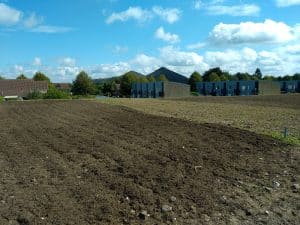
Green waste compost
Green waste compost is made up of organic plant matter such as dead leaves, branches, lawn clippings and tree and shrub prunings. This waste from gardening and the upkeep of green spaces is generally biodegradable. They can be recycled or transformed into compost to enrich the soil. Proper management of green waste is important for reducing environmental impact and helping to preserve biodiversity.
Biodepe, a subsidiary of the ECT Group, is one of the main players in green waste compost in Burgundy. Green waste compost combined with inert soil is used to make the fertile substrate produced by ECT.
Disposal of construction site soil
Site soil disposal refers to the process of moving surplus excavated soil out of the site right-of-way. When excavating for foundations, parking lots or land development, the quantity of soil removed often exceeds that which can be reused on site, particularly in dense urban areas.
In such cases, excess excavated soil must be disposed of in compliance with waste management regulations, and characterized according to its degree of pollution so that it can be properly processed.
ECT manages the disposal of surplus soil within a complete and strict traceability framework. The company reuses inert excavated soil as part of a circular economy. This inert soil is used to rehabilitate degraded sites. They are used for development projects in natural, agricultural or leisure areas.
In France, the disposal of soil from construction sites must comply with environmental and waste management regulations (Code de l’Environnement).
Biodiversity standard NF X32-001
AFNOR has created a voluntary standard to promote organizations’ commitment to biodiversity. The NF X32-001 standard “Biodiversity approach for organizations” is aimed at all types of organization. It aims to provide a tool adapted to the challenges of biodiversity conservation, restoration and sustainable use. The methodology enables you to analyze your impact on biodiversity, draw up an action strategy, monitor its implementation, evaluate it and make it part of an improvement process.
To find out more, click here to visit the AFNOR website.
Gross soil artificialization
The artificialization of the soil of a natural, agricultural or forest area is the result of development actions that can lead to its total or partial sealing. This change in land use is difficult to reverse and has harmful consequences for the environment.
Soil artificialisation is a direct consequence of urban sprawl and the construction of new housing on the outskirts of cities. Today, it is one of the main causes of climate change and the erosion of biodiversity.
The introduction of the “zero net artificialization” objective set out in the Biodiversity Plan is intended to force local authorities to rethink urban planning in order to reduce the artificialization of land.
Source: French Ministry of Ecological Transition
Biodiversity
Biodiversity is the diversity of living things. The term refers to all living beings and the ecosystems in which they live. This notion also includes the interactions of species with each other and with their environment.
There are 3 levels of biodiversity:
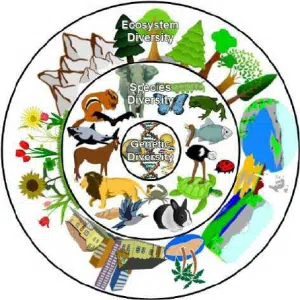
- Genetic diversity
- Species diversity
- Ecosystem diversity
Afforestation
ECT plants between 10,000 and 30,000 trees a year as part of the renaturation of its sites.
The species selected are local and adapted to local ecosystems.
Afforestation offers many benefits:
- recreate ecological environments consistent with their surroundings
- support the development of biodiversity
- create urban islands of freshness
- reinforcing the slopes and contours of our sites
- sequester carbon
Every year, we welcome over 300 children to our sites to take part in tree-planting and biodiversity awareness sessions.
Acoustic mound
The phonic mound, also known as phonic protection or phonic merlon, is a development designed to protect an area from noise pollution. Increased rail infrastructure and denser road traffic create a context of growing noise. Local authorities need to come up with a rapid development solution to restore and preserve the community’s living environment.
ECT’s inert soil protections are unbuilt. They improve the quality of residential life and enhance the attractiveness of the region. And to offer new places to walk and play sports thanks to their ecological renaturation and the creation of pathways.
In most cases, the noise barrier also provides additional visual insulation from the infrastructure that is the source of the noise.
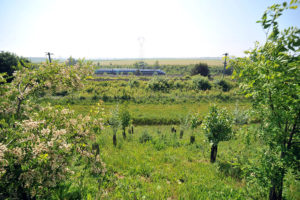
Photovoltaic plant
- increase photovoltaic energy production in Ile-de-France and Hauts-de-France regions
- developing a local approach: offering green electricity, financed and produced locally
- optimize the performance of photovoltaic power plants in northern France, by adapting the site’s shape to the inclination of the solar panels.
- promote the integration of photovoltaic plants into the landscape.
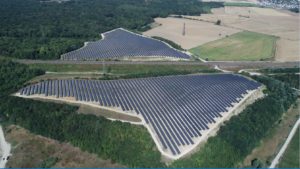
Thermal desorption
Thermal desorption is a process designed to extract volatile and semi-volatile pollutants from the soil by applying heat. This method eliminates pollutants. Excavated soil is fed into a furnace capable of reaching temperatures of between 90° and 560°, depending on the type of pollution to be treated.
This treatment is carried out by specialized centers.
Circular economy
The circular economy is a model of production and consumption that involves sharing, reusing, repairing, renovating and recycling existing products and materials.
The circular economy is one of the vectors of environmental transition.
ECT’s activity is part of a circular economy for excavated earth from construction and public works. ECT reuses them as materials in landscaping, ecological, sports, agricultural or photovoltaic projects. This reuse self-finances the project and “recycles” abandoned, damaged or fallow land. The new use of the site is discussed with the local authorities and landowners.
Ecosystem
An ecosystem is a community of living organisms (biocenosis) interacting with the physical environment in which they live – the biotope.
Ecosystem services are the benefits provided by ecosystems to human societies:
- Procurement services
- Regulatory services
- Support services
- Cultural services
These are the tangible and intangible benefits that humans derive from the way ecosystems function.
If ecosystems are degraded, so too are the benefits we can derive from them.
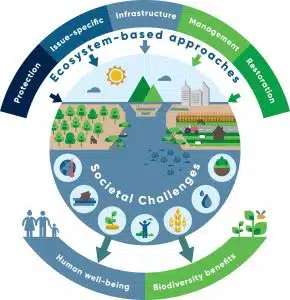
Invasive alien species (IAS)
Invasive alien species refer to certain animals and plants introduced by man, either voluntarily or involuntarily, into a territory. Their appearance outside their original ranges threatens ecosystems, natural habitats, local species and sometimes human health.
IAS are one of the 5 causes of the collapse of biodiversity.
Gravel
Rubble is a category of waste made up of small-sized debris, most often resulting from the demolition or collapse of buildings. Rubble can be class 3 (inert) or polluted.
Rubble crushed inert materials received on ECT sites are reused on our own sites. They are used as an underlay on our slopes to improve the bearing capacity of access roads. They account for less than 2% of materials received at ECT sites.
Incineration of polluted soil
Incineration is one of the oldest techniques for treating soil pollution. Its principle is based on aerobic combustion (in the presence of air) in a very high-temperature furnace (870 to 1,200°C). This process destroys or volatilizes pollutants.
This treatment of polluted soil is carried out in specialized centers.
Source: SelecDEPOL
ISO 14 001
ISO 14001 is a benchmark for companies wishing to integrate environmental aspects into their organization on a long-term basis. This international standard is used to establish an “environmental management system”. The EMS is built around an “environmental policy” that commits the company and its management. The definition of context, processes, challenges and objectives enables the company :
- reduce the impact of its activities on the environment
- continuously improve its environmental performance
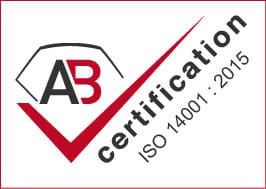
Land Art
Land art is a modern art movement that aims to place nature and natural materials at the heart of artistic creation.
This trend originated in the United States in the 1960s. Leading representatives include Robert Smithson and Michael Heizer.
The works, often gigantic, are integrated into an exceptional natural setting. Earthwork is a work whose basic material is earth.
In France, Antoine Grumbach has added an aerial art dimension to the concept of earthwork, inspired by the geoglyphs of Nazca in Peru. He designed “Les Yeux du Ciel” on the ECT site in Villeneuve-sous-Dammatin. This work represents 2 eyes, 400 meters long, excavated on ECT’s site for the reclamation of excavated earth from the construction industry.
Nature-based solutions
Nature-based Solutions (NBS) are defined by IUCN as activities that protect, sustainably manage or restore natural or modified ecosystems to directly address societal challenges in an effective and adaptive way, while ensuring human well-being and biodiversity benefits.
e are developments, structures or processes based on ecosystems that aim to adapt to current consequences. These are actions carried out by living organisms (species and ecosystems) in the dual service of man and nature. Source: OFB
SfN is based on the capacity of ecosystems to provide services that reduce carbon emissions into the atmosphere. Their potential to offer effective solutions is estimated at 37% of global emissions reduction by 2030. (Griscom et al. 2017)
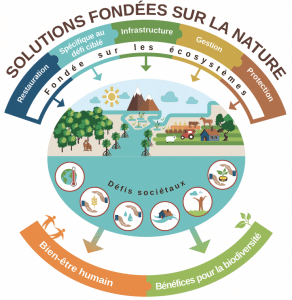
AGEC Act
Voted in 2020, the AGEC law is the “anti-waste for a circular economy” law.
It aims to accelerate change in production and consumption, limit waste and preserve natural resources, biodiversity and the climate.
It is structured around 4 main axes :
- Waste reduction and the end of disposable plastic by 2040
- Better consumer information
- Combating waste and prioritizing solidarity-based re-use
- Producer responsibility and the fight against illegal dumping.
The AGEC Act strengthens the traceability of excavated soil and materials:
- creating the National Register of Waste, Excavated Soil and Sediment (RNDT)
- making it compulsory for all players to keep a chronological register of excavated soil
The law also broadens the conditions under which many products can be removed from waste status.
Source: French Ministry of Ecological Transition
ALUR law
The ALUR law, is an official French government text to facilitate access to housing and promote renovated urban planning. The ALUR (Accès au Logement et Urbanisme Rénové) law was enacted in March 2014. This law makes great strides in facilitating the regulation of real estate markets and framing practices, promoting access to housing for households and developing innovation and transparency.
Source: Ministry of Ecological Transition
To find out more about the ALUR law, click here
Climate law and resilience
The Climate and Resilience Act is the result of the work of the Citizens’ Climate Convention. This law aims to combat climate change and strengthen resilience to its effects. Promulgated and published in the Journal Officiel on August 24, 2021, this law anchors ecology in our society: in public services, in our children’s education, in our urban planning, in our travel, in our consumption patterns and in our justice.
Source: French Ministry of Ecological Transition
Landscaped park
A landscaped garden or park is designed according to certain aesthetic criteria. Using specific techniques and materials, gives this landscape a “landscaped” look. Source Les Entreprises du Paysage
The landscaped park is a vast natural space that integrates nature into the city, helping to reconnect urban dwellers with nature. It is an integral part of cities’ climate and environmental transition policies and their attractiveness.
Thanks to the reuse of excavated soil, ECT creates urban parks with a wide range of shapes and equipment. The slopes will be reforested and public spaces landscaped. The strong plant and ecological component is complemented by outdoor leisure and sports facilities (fitness trail, children’s playground, benches, playgrounds). They are enhanced by pathways, most often accessible to PRMs.
These ECT facilities are returned to the community and open to the public free of charge.
2018 Biodiversity Plan
The Biodiversity Plan aims to strengthen France’s efforts to preserve biodiversity. It aims to mobilize levers to restore the plant and limit its deterioration. As of July 4, 2018, its aim is to improve the daily lives of French people and their future.
The plan is structured around 6 strategic priorities, 24 objectives and 90 actions. It takes a comprehensive look at the fight to preserve and restore biodiversity:
- Reclaiming biodiversity in the regions: curbing the artificialisation of natural and agricultural areas and reclaiming areas of biodiversity.
- Building an economy without pollution and with low impact on biodiversity: reconciling economic development and the preservation of biodiversity
-
Protecting and restoring nature in all its components: stepping up action on the most threatened ecosystems.
- Developing an ambitious European and international roadmap for biodiversity
- Knowledge, education and training: mobilizing all players and citizens around these issues
- Improving the effectiveness of biodiversity policies: for more efficient implementation
Source: French Ministry of Ecological Transition
Brownfield redevelopment
According to INSEE, a wasteland is “a built-up or undeveloped area, formerly used for industrial, commercial or other activities, abandoned for more than two years and measuring more than 2,000 m2”. But there are also agricultural wastelands (different from fallow land) and urban wastelands.
To facilitate their rehabilitation, numerous inventories of wasteland have been carried out. Cerema‘s. Or the Lifti.
Brownfield redevelopment enables the site to be put to a new social, environmental or agricultural use. It’s a development opportunity for the region on available land. Brownfield redevelopment has many environmental and economic advantages.
In some cases, brownfield redevelopment can :
- combating soil artificialisation
- recreating green grids, acting for biodiversity
- contribute to the economic revitalization of a region
Soil renaturation
Article L101-2-1 of the French urban planning code characterizes soil renaturation as an action “to restore or improve the functionality of a soil, having the effect of transforming an artificial soil into a non-artificial soil”.
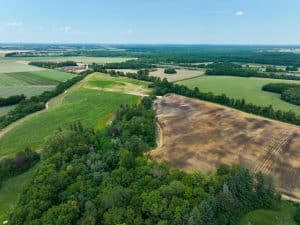
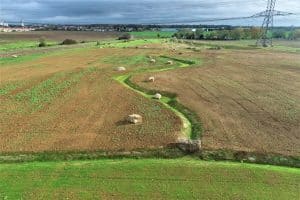
Tunnel-boring soil
Tunnel-boring soil is produced by the excavation of a tunnel-boring machine.
The chemical characterization of this soil is similar to that of conventional excavated soil. They can be class 3, class 2 or class 1.
Their distinctive “toothpaste” appearance is the result of the action of the tunnel boring machine, which destructures the ground in order to excavate it.
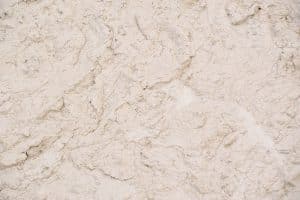
Excavated earth
Excavated soil corresponds to excavated soil originally in place. This soil mainly comes from construction sites (building, public works or landscaping). They come from earthworks, foundations and parking lot excavations.
Excess soil, i.e. soil that cannot be reused on the site, is removed. They then take on the legal status of waste.
French regulations stipulate that excavated soil must be disposed of through appropriate treatment or recycling channels, depending on its type (inert, non-hazardous, hazardous).
The management of excavated soil represents a major challenge in many areas: economic, logistical and environmental.
French regulations also provide for a chain of traceability, reinforced by the AGEC law.
Source : Infoterre
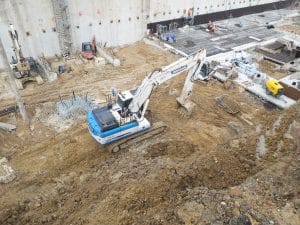
Class 2 / K2 excavated soil
Class 2 excavated soil, or K2, is non-hazardous soil. They are processed at specialized sites known as Installations de Stockage de Déchets Non Dangereux (ISDN – non-hazardous waste storage facilities).
These Class 2 soils and materials contain concentrations of chemical compounds above the thresholds for inert soils.
The ECT center for the biological treatment of hydrocarbon-polluted soil at La Courneuve can handle class 2 soil.
Class 3 / K3 excavated soil
Excavated soil from class 3, or K3, is inert soil. They are hosted in Inert Waste Storage Facilities or used in Development projects . Qualification thresholds were set by a ministerial order dated 12/12/2014.
These materials are called inert because they do not undergo physical, chemical or biological modification. They do not decompose, burn or produce any other physical or chemical reaction.
They do not pollute the environment or harm human health.
Class 3 + / K3+ excavated soil
Class 3+, or K3+, excavated soil corresponds to inert soil with increased thresholds. These soils have higher concentration thresholds for certain substances than those set by the ministerial order of 12/12/2014. This soil remains inert.
Class 1 excavated earth – K1
This is hazardous polluted soil. They are recognized as dangerous for the natural environment or living beings. They are stored in hazardous waste landfills (CSDD).
ECT does not manage this type of soil and outsources its treatment to landfill sites.
Polluted excavated soil
Polluted soil is the result of accidental, residual or historical soil pollution.
These soils pose a risk to health and the environment. They constitute non-inert waste that must be managed by authorized operators for excavation, transport and treatment, in compliance with current regulations.
They are a special classification of waste codes.
ECT has specific expertise in the treatment of soil polluted by hydrocarbons, thanks to its biological treatment center located in La Courneuve (93).
Hydrocarbon-polluted excavated soil
Soil pollution with hydrocarbons can result from accidental, residual or historical soil pollution. Soil impacted by hydrocarbons must be treated at a special center.
ECT has expertise in the treatment of hydrocarbon-polluted soil. They are housed at the La Courneuve (93) treatment center for hydrocarbon-polluted soil.
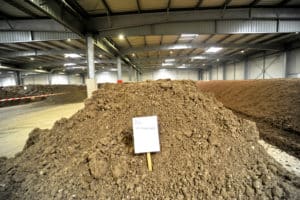
Inert soil
Excavated soil and inert materials are defined in article R541-8 of the French Environment Code.
These are soils and materials that do not change physically, chemically or biologically, and do not alter their environment. Inert materials do not decompose
do not burn or produce any other physical or chemical reaction. They are non-biodegradable and do not damage other materials with which they come into contact in a way that could pollute the environment or harm human health.
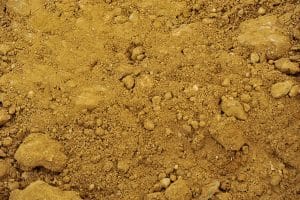
Land treatment
There are different types of spoil generated by the construction industry. These lands are categorized as follows:
- inert soil
- non-inert and non-hazardous waste
- hazardous spoil.
ECT recovers inert soil from construction sites to create non-built developments, and also recovers certain natural soils after checking that they have no impact on health and the environment.
Other types of soil are handled by external service providers, as they require very specific treatment. These lands are subject to strict regulations. They are sent to the appropriate channels.
ECT can treat soil impacted by hydrocarbons at its unique center in France, located in La Courneuve (93).
UDTM – Wetlands Decanting Unit
UDTM stands for Unité de Décantation des Terres Mouillées. These units can accommodate excavated soil of very low dryness, which would therefore not be suitable for ISDI.
Dryness corresponds to the percentage of dry matter.
ECT has a UDTM at its Villeneuve-sous-Dammartin site.
Land reclamation
Not all excavated soil can be recycled in the same way. Some soils can be reused or recycled, while others need to be disposed of or treated in a special way, as they are said to be polluted or hazardous.
ECT assists its customers in the recovery of inert soil, which is reused in non-built development projects to recreate fertile soils.
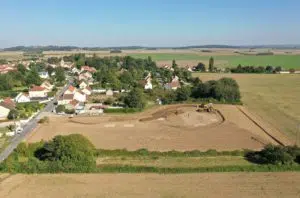
ZAN – Zero Net Artificialization
ZAN stands for “Zéro artificialisation Nette” (Zero Net Artificialization). This is a principle laid down by the“Climate and Resilience” law of August 22, 2021, which deals with the fight against climate disruption.
The ZAN principle was born out of an observation about the consequences of urban sprawl and the resulting artificialization of land on :
- climate change
- erosion of biodiversity
- increased flood risk
- the reduction of agricultural land
The two main objectives of these regulations are :
- a 50% reduction in the rate of consumption of natural, agricultural and forest areas between 2021 and 2031
- no land consumption by 2050
Source: OFB
The vast majority of ECT’s projects contribute to communities’ ZAN objectives through undeveloped, permeable soils.
